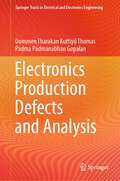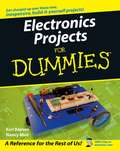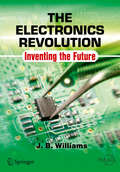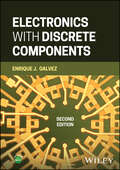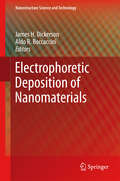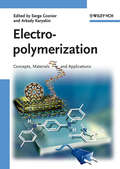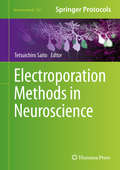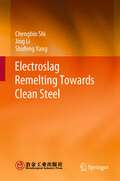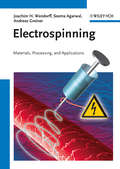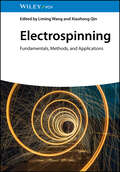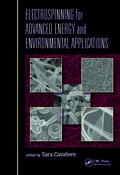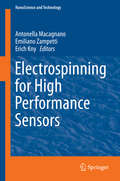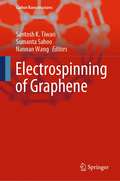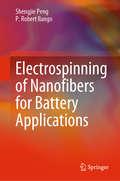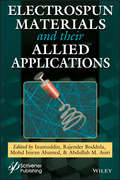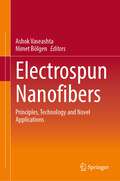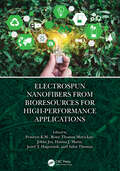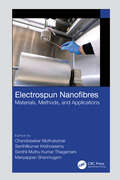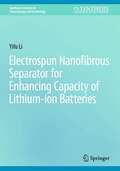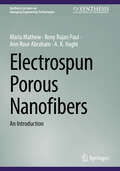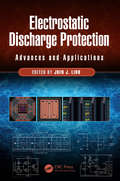- Table View
- List View
Electronics Production Defects and Analysis (Springer Tracts in Electrical and Electronics Engineering)
by Oommen Tharakan Kuttiyil Thomas Padma Padmanabhan GopalanThis book is a unique book capturing defects that are frequently encountered during various fabrication phases of electronic packages. These defects have been analyzed to their root cause and mitigation techniques and presented in the book. The book includes 228 cases with more than 480 color and magnified images of the defects. These defects are covered under eight subheads, viz soldering defects, PCB defects, mounting defects, conformal coating and potting defects, EEE component defects, workmanship defects, defects due to usage of non-FFF components, and defects in CAD layout. The possible reasons for the occurrence of the defects and the methods/practices by which they can be eliminated/mitigated have also been discussed. The chapter "mounting defects" shows the correct approach in the adjacent photograph, so that the users can refer to the right procedures. The book is helpful to those who are involved in the production of electronics packages to familiarize them with the different cases shown carefully and revised frequently. Exposure to the different defects is useful to all who are working in fabrication and quality control to realize a zero-defect product sans much time and investment. The book is valuable for the technical community working for aerospace applications, industry partners in the realization of space programs, aerospace, and high-reliability institutions, various electronic fabrication agencies in the country, engineers and technicians taking up courses in high-reliability soldering and fabrication techniques, and the students.
Electronics Projects For Dummies
by Nancy C. Muir Earl BoysenThese projects are fun to build and fun to useMake lights dance to music, play with radio remote control, or build your own metal detectorWho says the Science Fair has to end? If you love building gadgets, this book belongs on your radar. Here are complete directions for building ten cool creations that involve light, sound, or vibrations -- a weird microphone, remote control gizmos, talking toys, and more, with full parts and tools lists, safety guidelines, and wiring schematics.Check out ten cool electronics projects, including* Chapter 8 -- Surfing the Radio Waves (how to make your own radio)* Chapter 9 -- Scary Pumpkins (crazy Halloween decorations that have sound, light, and movement)* Chapter 12 -- Hitting Paydirt with an Electronic Metal Detector (a project that can pay for itself)Discover how to* Handle electronic components safely* Read a circuit diagram* Troubleshoot circuits with a multimeter* Build light-activated gadgets* Set up a motion detector* Transform electromagnetic waves into soundCompanion Web site* Go to www.dummies.com/go/electronicsprojectsfd* Explore new projects with other electronics hobbyists* Find additional information and project opportunities
The Electronics Revolution
by J. B. WilliamsThis book is about how electronics, computing, and telecommunications have profoundly changed our lives - the way we work, live, and play. It covers a myriad of topics from the invention of the fundamental devices, and integrated circuits, through radio and television, to computers, mobile telephones and GPS. Today our lives are ruled by electronics as they control the home and computers dominate the workspace. We walk around with mobile phones and communicate by email. Electronics didn't exist until into the twentieth century. The industrial revolution is the term usually applied to the coming of steam, railways and the factory system. In the twentieth century, it is electronics that has changed the way we gather our information, entertain ourselves, communicate and work. This book demonstrates that this is, in fact, another revolution.
Electronics with Discrete Components
by Enrique J. GalvezComprehensive textbook on electronics for physicists, now with more examples, exercises, hands-on electronics labs, troubleshooting tips, and practical exercises Electronics with Discrete Components delivers a comprehensive overview of electronics from the perspective of a physicist. In the first part on digital components, after an introduction to digital electronics, the text covers fundamentals of combinational logic and its implementation in combinational logic devices, followed by sequential-logic devices such as flip-flops and memory components. The second part on analog components deals with the fundamentals of signal processing, filters, components such as diodes and transistors, and a lengthy coverage of operational amplifiers. Each chapter ends with problem sets and “lab projects” that have been proven to work well for instruction. Questions on simple aspects of the lab that students should know are also included, such as regarding powering components and diagnosing signals with the oscilloscope and providing “troubleshooting tips” to help students find out why a particular circuit does not work. The new edition of this textbook adds more worked examples, exercises with answers for the self-learner, and end-of-chapter problems. It adds new electronic components, covers the latest digital technologies plus adds a new section of Fourier transforms in electronics. In addition, it features labs with Arduino or Teensy boards which have become widespread in the community as inexpensive, easy-to-use electronics platforms. Electronics with Discrete Components includes information on: Number systems, codes, signed numbers, binary functions, logic families, and IC wiringsFilters and the frequency domain, covering RC, high- and low-pass, and cascading filters, FFTs, as well as important considerations for filter designConnecting digital to analog and to the world through TTL, CMOS, and LV gates and interfacing between the logic familiesCharge and potential, capacitors, electrical current, resistors, magnetic components, power, circuits, and abstractions and symbol jargon in the field The Second Edition of Electronics with Discrete Components is an ideal textbook resource for a one-semester course on electronics for second-year physics students, as well as students from other disciplines or levels who understand elementary notions of circuits and complex numbers.
Electrophoretic Deposition of Nanomaterials
by Aldo R. Boccaccini James H. DickersonThis book provides a comprehensive overview of contemporary basic research, emerging technology, and commercial and industrial applications associated with the electrophoretic deposition of nanomaterials. This presentation of the subject includes an historical survey, the underlying theory of electrophoresis, dielectrophoresis, and the colloidal deposition of materials. This is followed by an assessment of the experimental equipment and procedures for electrophoretic and dielectrophoretic aggregation, manipulation, and deposition of nanoparticles, nanotubes, and other nanomaterials. Additional chapters explore the specific science and technology of electrophoretic film formation, using widely studied and application-driven nanomaterials, such as carbon nanotubes, luminescent nanocrystals, and nano-ceramics. The concluding chapters explore industrial applications and procedures associated with electrophoretic deposition of nanomaterials.
Electroplating and Electroforming: A Guide For The Craftsman
by Lee Newman Jay H. NewmanReviews the history, materials, and techniques of electroplating and electroforming, current craft and commercial processes, and contemporary forms, outlining instructions for a number of creative projects
Electropolymerization: Concepts, Materials and Applications
by Serge Cosnier Arkady KaryakinProviding extensive coverage, including conducting, insulating and electroactive films, this handbook and ready reference deals with introductory topics and fundamentals as well as advanced insights. Clearly structured, in the first part of the book readers learn the fundamentals of electropolymerizatoin for all important types of polymers, mechanisms of film formation and functionalization, while the second part covers a wide range of applications in biochemistry, analytics, photovoltaics, energy and the environment as well as actuators.
Electroporation Methods in Neuroscience
by Tetsuichiro SaitoThis volume describes the methods of both in vivo and in vitro electroporation using ferrets, rats, mice, chickens, and zebrafish. Recent advances of experiments using the tetracycline-regulated gene expression and Tol2 transposon systems are also included. Written in the popular Neuromethods series style, chapters include the kind of detail and key advice from the specialists needed to get successful results in your own laboratory. Practical and authoritative, Electroporation Methods in Neuroscience serves to aid scientists in the further study into this crucially important way to study cells.
Electroslag Remelting Towards Clean Steel
by Chengbin Shi Jing Li Shufeng YangThis book introduces the results that the authors have achieved on the study of functional principle of electroslag remelting for production of high-quality clean steel. The dependence of oxygen, sulfur, and non-metallic inclusions on the processing parameters of electroslag remelting is assessed. The fundamentals and technologies of clean steel production by electroslag remelting have been applied in the round to discuss oxygen, sulfur, and non-metallic inclusions evolution and control. A general concluding remark and a perspective for future work are present. The book is likely to be of interest to university teachers, researchers, R&D engineers, and graduate students in material processing and pyrometallurgy who wish to explore innovative technologies that lead to more energy-efficient and environmentally sustainable clean steel production.
Electrospinning
by Andreas Greiner Seema Agarwal Joachim H. WendorffElectrospinning is from the academic as well as technical perspective presently the most versatile technique for the preparation of continuousnanofi bers obtained from numerous materials including polymers, metals, and ceramics. Shapes and properties of fibers can be tailoredaccording to the demand of numerous applications including filtration, membranes, textiles, catalysis, reinforcement, or biomedicals.This book summarizes the state-of-the art in electrospinning with detailed coverage of the various techniques, material systems and theirresulting fiber structures and properties, theoretical aspects and applications.Throughout the book, the current status of knowledge is introduced with a critical view on accomplishments and novel perspectives. Anexperimental section gives hands-on guidance to beginners and experts alike.
Electrospinning: Fundamentals, Methods, and Applications
by Liming Wang Xiaohong QinElectrospinning Unique resource highlighting new methods and emerging applications of electrospinning, such as manufacturing of nanofiber yarn, solar steam generation, thermoelectric generators, water-induced electric generators, actuators, and biomedical applications. Electrospinning introduces the basic principles and state-of-the-art methods of electrospinning in depth and continues on to highlight the most relevant and recent applications associated with the remarkable features of nanofibers. Written by two highly qualified authors with significant experience in the field, Electrospinning includes information on: History and development of the electrospinning theories and the state-of-the-art methods for fiber structure regulation, mass production of electrospun fibers, and manufacturing of electrospun fiber yarnsElectrospinning nanofiber-based evaporators for interfacial solar-driven steam generation and preparation and application of electrospun nanofibers in heat insulationResearch progress on sound absorption of electrospun fibrous materials and electrospun nanofiber-based triboelectric nanogeneratorPreparation and application of thermoelectric materials and devices based on electrospun fibers and electrospun nanofiber-based water-induced electric-generation Providing a comprehensive overview of electrospinning, including the principle, methods, and latest applications, Electrospinning is an essential resource for materials scientists, polymer chemists, chemists in industry, electrochemists, catalytic chemists, and electronics engineers.
Electrospinning for Advanced Energy and Environmental Applications
by Sara CavaliereElectrospinning for Advanced Energy and Environmental Applications delivers a state-of-the-art overview of the use of electrospun fibers in energy conversion and storage, as well as in environmental sensing and remediation. It first introduces electrospinning and its origins, outlining achievable one-dimensional nanoscaled materials and their applications. It then discusses the use of electrospun materials in energy devices, including low- and high-temperature fuel cells, hydrogen storage, dye-sensitized solar cells, lithium-ion batteries, and supercapacitors. It also explores environmental applications, such as the use of electrospinning-issued materials in membranes for water and air purification, and in sensors and biosensors for pollution control.
Electrospinning for Advanced Energy Storage Applications (Materials Horizons: From Nature to Nanomaterials)
by Neethu T. M. Balakrishnan Raghavan PrasanthThis book provides a consolidated description of the process of electro-spinning and detailed properties and applications of electro-spun electrodes and electrolytes in energy storage devices. It discusses the preparation, structure and electrochemical properties of nanofiber electrode and electrolyte materials. It focuses exclusively on Lithium Ion batteries, with the contents discussing different aspects of electrospinning in storage systems. This book aims to provide a comprehensive resource to help researchers choose the best electrodes and electrolyte materials based on the properties required for their desired commercial applications. It will be a useful guide to graduate students and researchers working in solid-state chemistry, physics, materials chemistry, and chemical engineering on aspects of energy storage.
Electrospinning for High Performance Sensors
by Antonella Macagnano Emiliano Zampetti Erich KnyThis book aims to present the different aspects of electrospinning for designing and fabricating high performing materials for sensors applied in gaseous and liquid environments. Since electrospinning is a versatile and inexpensive manufacturing technology, the book emphasizes the industrial applications perspective. The volume is an edited collection of the most recent and encouraging results concerning advanced nanostructured (bio) sensors. The feats achieved by these sensors range from high sensitivity to extreme operating conditions and satisfy a wide range of requirements. Most of the contributions in this book come from First International Workshop on "Electrospinning for High Performance Sensing "(EHPS2014) that was held in Rome in 2014, as part of the European COST Action MP1206 "Electrospun Nanofibres for bio inspired composite materials and innovative industrial applications. "
Electrospinning of Graphene (Carbon Nanostructures)
by Santosh K. Tiwari Sumanta Sahoo Nannan WangThis book presents electrospinning as a processing technique in the field of graphene research. It brings together the current state of the art of processing, properties, and applications in different fields of science and technology of graphene and derived materials. The book not only discusses the various aspects of electrospun graphene but also covers the limitation and drawbacks of graphene owing to some of its intrinsic properties.
Electrospinning of Nanofibers for Battery Applications
by Shengjie Peng P. Robert IlangoThis book comprehensively discusses the basic principles and working mechanism of all kind of batteries towards clean energy storage devices. In addition, it focuses on the synthesis of various electrode materials with 1D architecture via electrospinning technique. This book will give a clear idea about recent synthetic strategy towards nanofibers and nanocomposites for alkali-ion storage applications. The reader could understand the formation mechanism of nanofibers and their potential application in the future energy storage system.
Electrospun Materials and Their Allied Applications
by Rajender Boddula Inamuddin Mohd Imran Ahamed Abdullah M. AsiriThe aim of this book is to explore the history, fundamentals, manufacturing processes, optimization parameters, and applications of electrospun materials. The book includes various types of electrospun materials such as antimicrobial, smart, bioinspired systems. It focuses on the many application areas for electrospun materials such as energy storage and harvesting, catalysis, biomedical including gene delivery and tissue engineering, separation, adsorption and water treatment technologies, packaging. The book emphasizes the enhanced sustainable properties of electrospun materials, with the challenges and future developments being discussed in detail. The chapters are written by top-class researchers and experts from throughout the world.
Electrospun Nanofibers: Fabrication, Functionalisation and Applications (Springer Series on Polymer and Composite Materials)
by Santosh Kumar Tiwari Kashma Sharma Vishal Sharma Vijay KumarThe book provides an up-to-date account of the various techniques of fabrication & functionalization of electrospun nanofibers as well as recent advancements. An overview of the advanced applications of such techniques in different areas is also presented. Both experimental and theoretical approaches related to electrospun nanofibers are covered along with a discussion on the inherent properties of electrospun nanofibers. Therefore, this book provides a unique resource not only to established researchers but also newcomers starting out in this field.
Electrospun Nanofibers: Principles, Technology and Novel Applications
by Ashok Vaseashta Nimet BölgenThis book presents the development of electrospun materials, fundamental principles of electrospinning process, controlling parameters, electrospinning strategies, and electrospun nanofibrous structures with specific properties for applications in tissue engineering and regenerative medicine, textile, water treatment, sensor, and energy fields. This book can broadly be divided into three parts: the first comprises basic principles of electrospinning process, general requirements of electrospun materials and advancement in electrospinning technology, the second part describes the applications of electrospun materials in different fields and future prospects, while the third part describes applications that can be used in advanced manufacturing based on conjoining electrospinning and 3D printing. Electrospinning is the most successful process for producing functional nanofibers and nanofibrous membranes with superior chemical and physical properties. The unique properties of electrospun materials including high surface to volume ratio, flexibility, high mechanical strength, high porosity, and adjustable nanofiber and pore size distribution make them potential candidates in a wide range of applications in biomedical and engineering areas. Electrospinning is becoming more efficient and more specialized in order to produce particular fiber types with tunable diameter and morphology, tunable characteristics, having specific patterns and 3D structures.With a strong focus on fundamental materials science and engineering, this book provides systematic and comprehensive coverage of the recent developments and novel perspectives of electrospun materials. This comprehensive book includes chapters that discuss the latest and emerging applications of nanofiber technology in various fields, specifically in areas such as wearable textile, biomedical applications, energy generation and storage, water treatment and environmental remediation, and sensors such as biomarkers in healthcare and biomedical engineering. Despite all these advancements, there are still challenges to be addressed and overcome for nanofiber technology to move towards maturation.
Electrospun Nanofibers from Bioresources for High-Performance Applications
by K. M. Praveen Rony Thomas Murickan Jobin Joy Hanna J. Maria Jozef T. Haponiuk Sabu ThomasNanofibers are possible solutions for a wide spectrum of research and commercial applications and utilizing inexpensive bio-renewable and agro waste materials to produce nanofibers can lower manufacturing cost via electrospinning. This book explains synthesis of green, biodegradable, and environmentally friendly nanofibers from bioresources, their mechanical and morphological characteristics along with their applications across varied areas. It gives an elaborate idea on conductive polymers for tissue engineering application as well. Features: Provides insight about electrospun nanofibers from green, biodegradable and environmentally friendly bio resources. Reviews surface characterization of electrospun fibers. Covers diversified applications such as cancer treatment, COVID-19 solutions, food packaging applications, textile materials, and flexible electronic devices. Describes the combined use of 3D printing and electrospinning for tissue engineering scaffolds. Includes Melt electrospinning technique and its advantages over Solution electrospinning This book aims at Researchers and Graduate Students in Material Science and Engineering, Environmental Engineering, Chemical Engineering, Electrical Engineering, Mechanical Engineering, and Biomedical Engineering.
Electrospun Nanofibres: Materials, Methods, and Applications
by Chandrasekar Muthukumar Senthilkumar Krishnasamy Senthil Muthu Kumar Thiagamani Mariyappan ShanmugamElectrospinning is a versatile method to synthesize fiber materials. Electrospun Nanofibres: Materials, Methods, and Applications explores the technical aspects of electrospinning methods used to derive a wide range of functional fiber materials and their applications in various technical sectors. As electrospinning is a process that can be modified strategically to achieve different fibers of interest, this book covers the wide spectrum of electrospinning methodologies, such as coaxial, triaxial, emulsion, suspension, electrolyte and gas-assisted spinning processes. It: • Discusses a broad range of materials, including synthetic polymers, biodegradable polymers, metals and their oxides, hybrid materials, nonpolymers, and more. • Reviews different electrospinning methods and combined technologies. • Describes process-related parameters and their influence on material properties and performance. • Examines modeling of the electrospinning process. • Highlights applications across different industries. This book is aimed at researchers, professionals, and advanced students in materials science and engineering.
Electrospun Nanofibrous Separator for Enhancing Capacity of Lithium-ion Batteries (Synthesis Lectures on Green Energy and Technology)
by Yifu LiThis book offers an in-depth exploration of battery separators, a critical component in Lithium-ion batteries (LIBs). Serving as insulators between electrodes to prevent internal short circuits, these separators play a crucial role in retaining liquid electrolyte and facilitating the migration of lithium ions during battery cycling. In the face of increasing demand for high-performance LIBs across diverse applications, the development of superior separators is imperative. Among the various advancements in battery separator research, electrospun nanofibrous separators have gained significant attention. These separators exhibit compelling characteristics, including large pore size (typically above 500 nm), high porosity (typically above 70%), and an interconnected porous structure, all of which enhance ion transportation efficiency and battery cycling performance. However, a notable focus in previous studies has been on electrochemical inert materials as battery separators, which do not contribute to the battery's capacity. This book presents a comprehensive study that introduces a novel concept: the development of a redox-active separator based on electrospun polypyrrole (PPy) composite nanofibers to significantly enhance battery capacity. The book begins by exploring the effects of separators on battery performance, providing valuable insights and guidance for separator design. Then, a detailed investigation into the kinetics of in-situ polymerization of PPy with electrospun fibrous membranes as templates follows, shedding light on the mechanisms behind fabricating the proposed separator. Finally, this book presents the fabrication and characterization of the proposed separator, showcasing potential of the separator for enhancing battery capacity. This book is intended for researchers, engineers, and professionals in the field of battery technology, materials science, and electrochemistry. It is also a valuable resource for graduate students and academics seeking advanced insights into the development of high-performance lithium-ion batteries and innovative separator technologies.
Electrospun Polymeric Nanofibers: Insight into Fabrication Techniques and Biomedical Applications (Advances in Polymer Science #291)
by R. JayakumarThis volume deals with the various fabrication techniques, surface functionalization and biomedical applications of polymeric fibers possessing different scale and structure. It provides an overview of fabrication techniques such as Co-axial, Centrifugal, Melt and Yarning to procure multiscale, tubular and layered fibrous scaffold employed for biomedical applications. The chapters in this volume discusse the surface/chemical functionalization of fibers which enhance the biological properties of the fibrous scaffolds as well as the development of hybrid, layered and external stimuli-responsive fibrous scaffolds that hold potential application in biosensor and other biomedical fields. In addition, recent advances and applications of polymeric multiscale fibers in tissue engineering, regenerative medicine and drug delivery are presented. The potential use of fibrous scaffolds in bone, neural, tendon/ligament and cardiac tissue engineering, nanofibers as an antimicrobial wound dressing, employed in cancer theragnostics and in the treatment of skin/periodontal infections are discussed. The volume provides expert knowledge on the fabrication techniques, development of different scale and hybrid structure fibers, surface functionalization, layered and external stimuli responsive fibrous scaffolds. It will be beneficial to material/biomaterials scientists, bioengineering and biotechnologists by providing a better understanding on the subject of the innovative applications of fibrous scaffolds in drug delivery, tissue engineering, wound dressings and regenerative medicine.
Electrospun Porous Nanofibers: An Introduction (Synthesis Lectures on Emerging Engineering Technologies)
by Maria Mathew Rony Rajan Paul Ann Rose Abraham A. K. HaghiThis book introduces readers to electrospinning, a nanofabrication technique used to produce nanofibers, and discusses the properties and applications of these nanofibers. The book begins with an overview of the electrospinning process, and strategies for producing nanofibers with different morphologies. The advantages and limitations of the nanofiber technology, and future outlook are addressed next. Then recent and novel applications of electrospun nanofibers in different areas including biomedical, environmental, textile and energy are discussed, followed by a more detailed review of the fabrication and properties of electrospun nanofiber membranes and composites.
Electrostatic Discharge Protection: Advances and Applications (Devices, Circuits, and Systems #46)
by Juin J. LiouElectrostatic discharge (ESD) is one of the most prevalent threats to electronic components. In an ESD event, a finite amount of charge is transferred from one object (i.e., human body) to another (i.e., microchip). This process can result in a very high current passing through the microchip within a very short period of time. Thus, more than 35 percent of single-event chip damages can be attributed to ESD events, and designing ESD structures to protect integrated circuits against the ESD stresses is a high priority in the semiconductor industry. <P><P>Electrostatic Discharge Protection: Advances and Applications delivers timely coverage of component- and system-level ESD protection for semiconductor devices and integrated circuits. Bringing together contributions from internationally respected researchers and engineers with expertise in ESD design, optimization, modeling, simulation, and characterization, this book bridges the gap between theory and practice to offer valuable insight into the state of the art of ESD protection. Amply illustrated with tables, figures, and case studies, the text: <P><P>Instills a deeper understanding of ESD events and ESD protection design principles Examines vital processes including Si CMOS, Si BCD, Si SOI, and GaN technologies Addresses important aspects pertinent to the modeling and simulation of ESD protection solutions Electrostatic Discharge Protection: Advances and Applications provides a single source for cutting-edge information vital to the research and development of effective, robust ESD protection solutions for semiconductor devices and integrated circuits.
